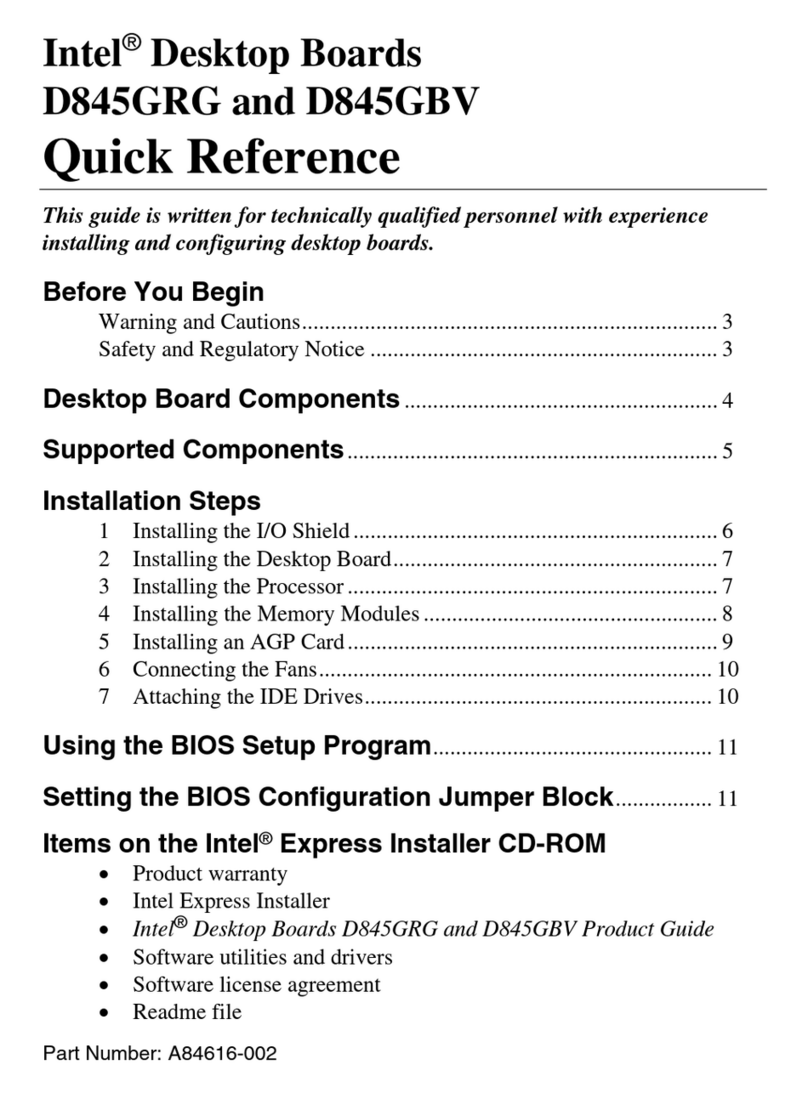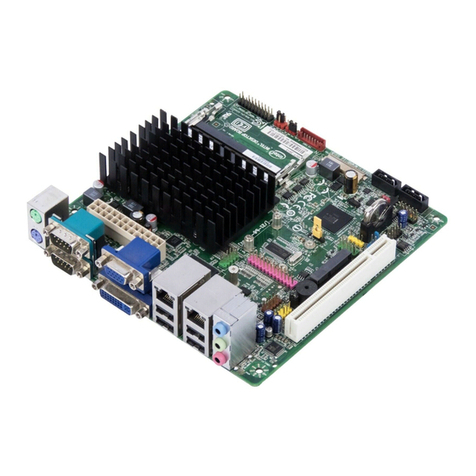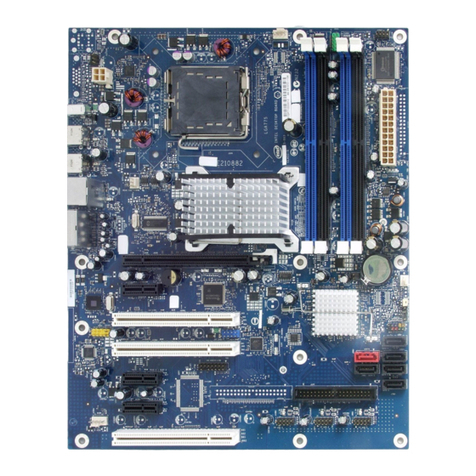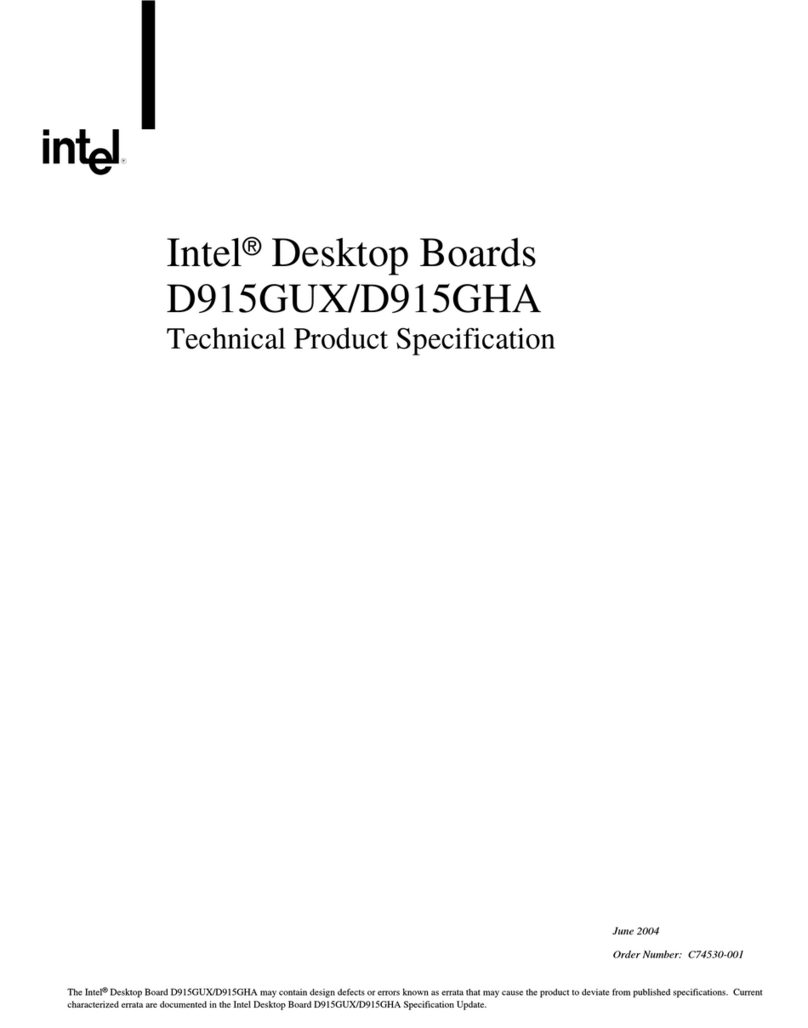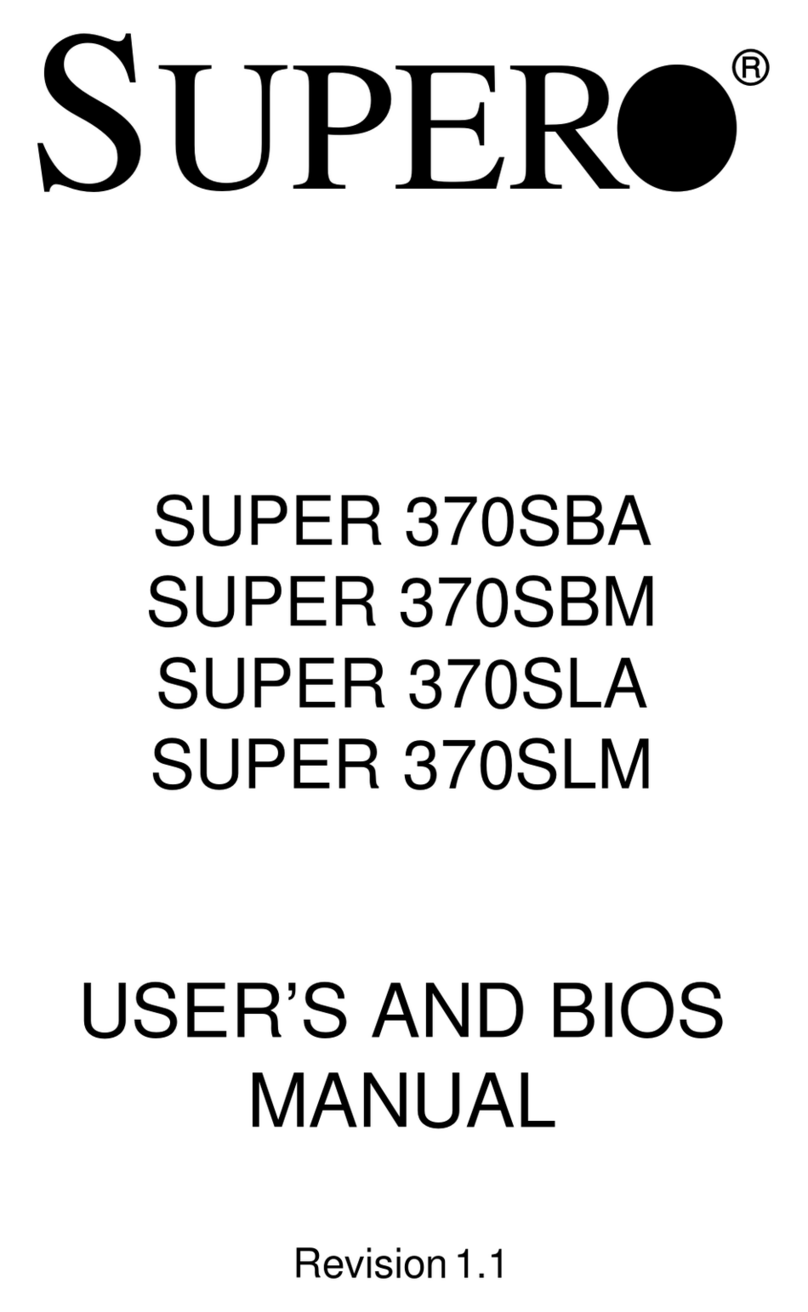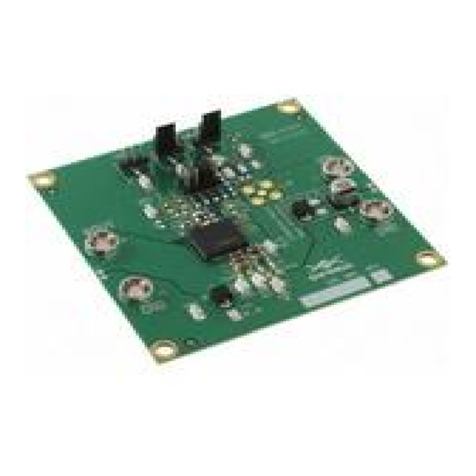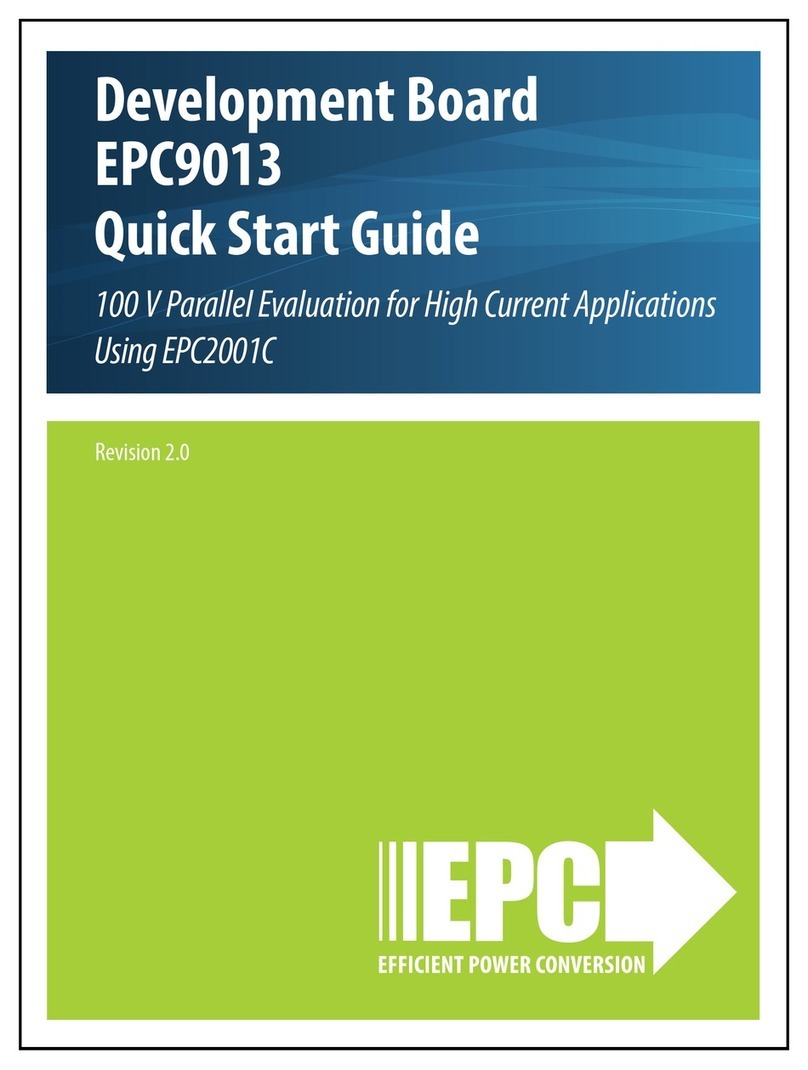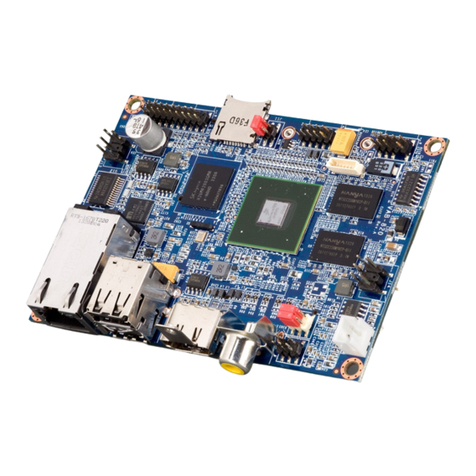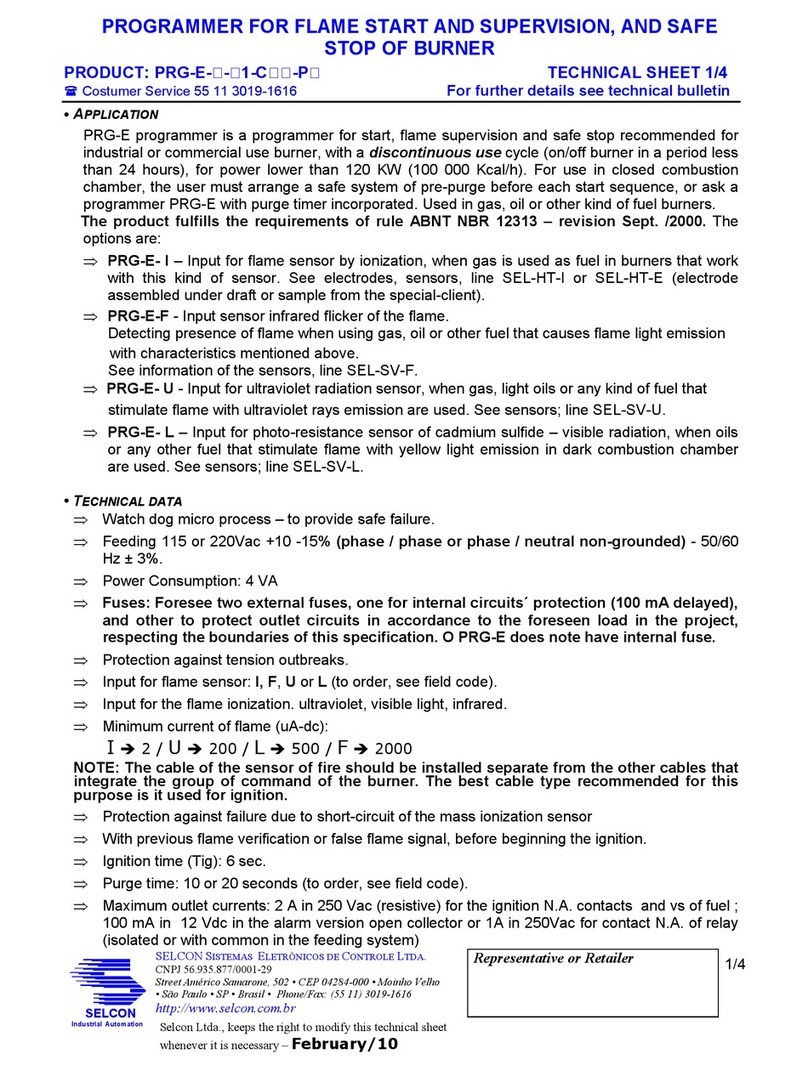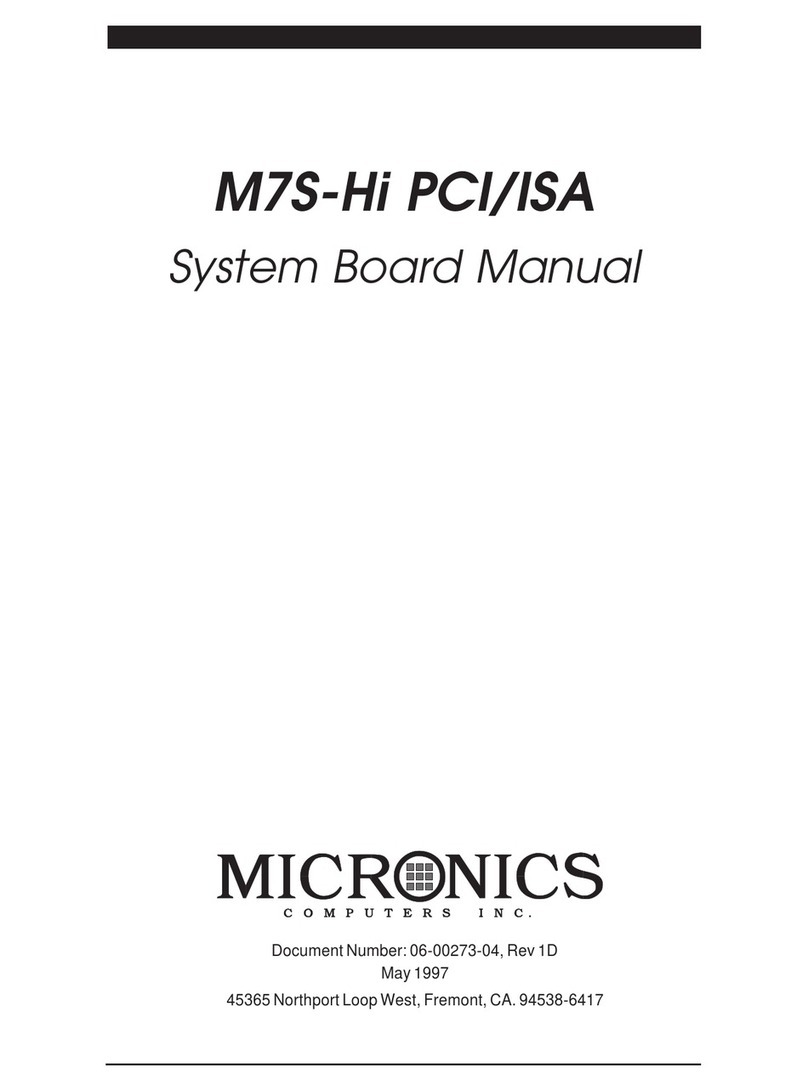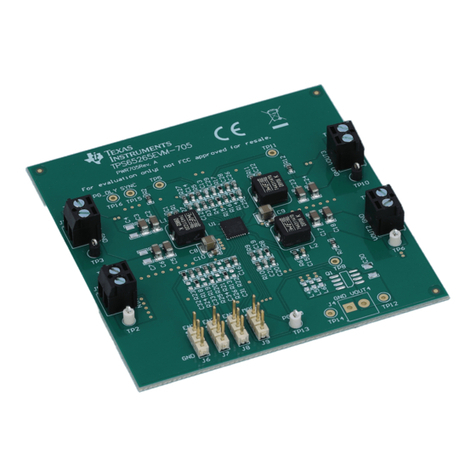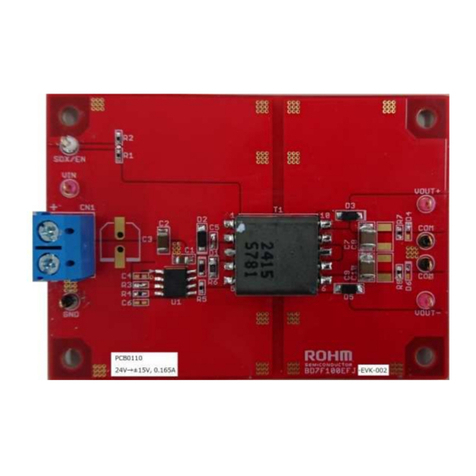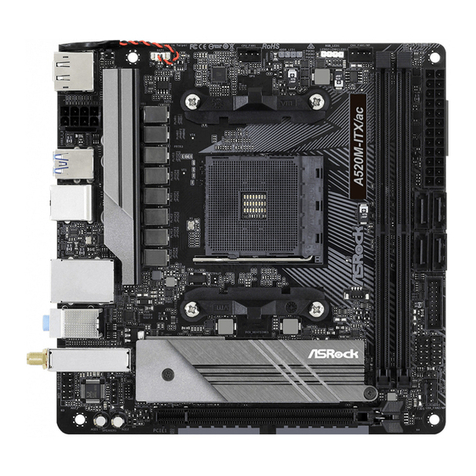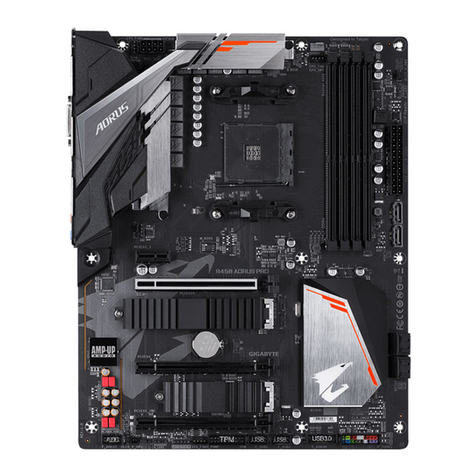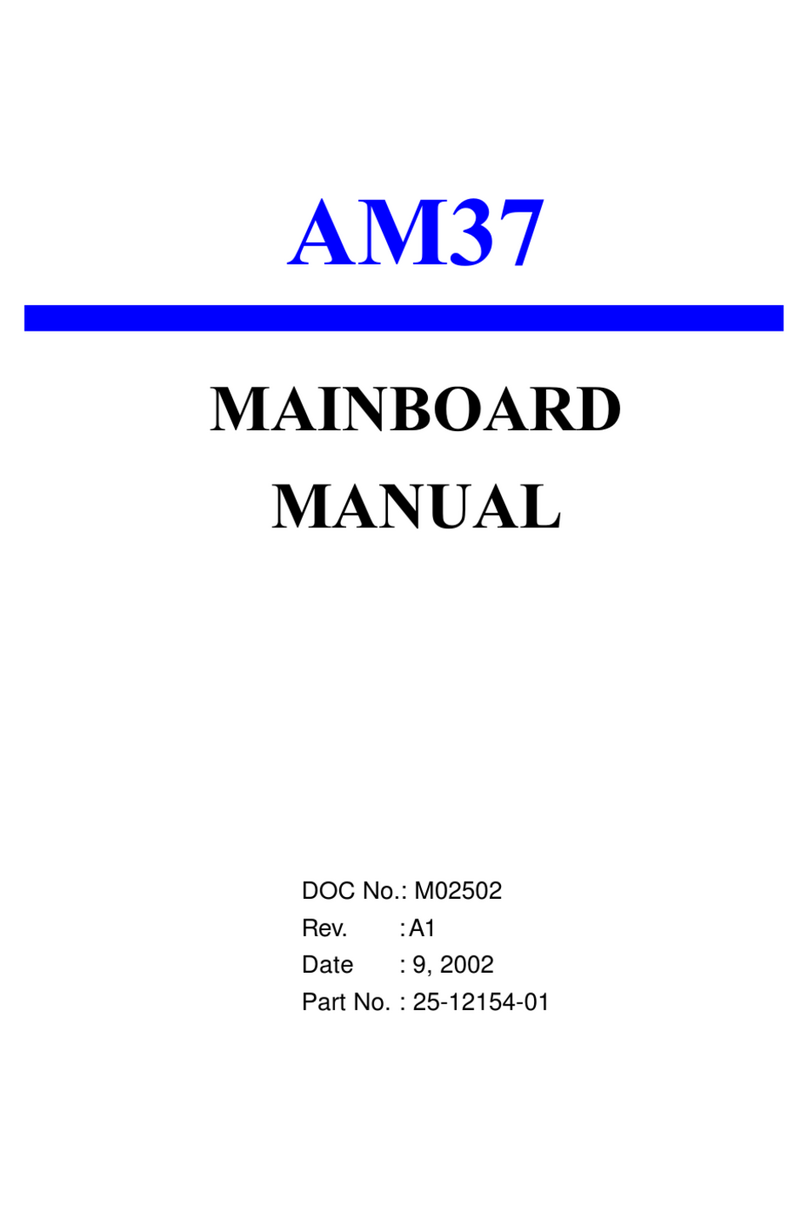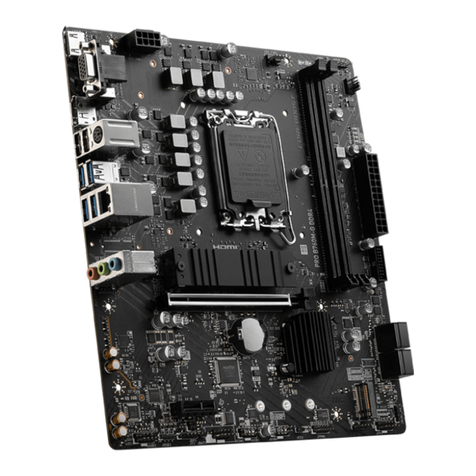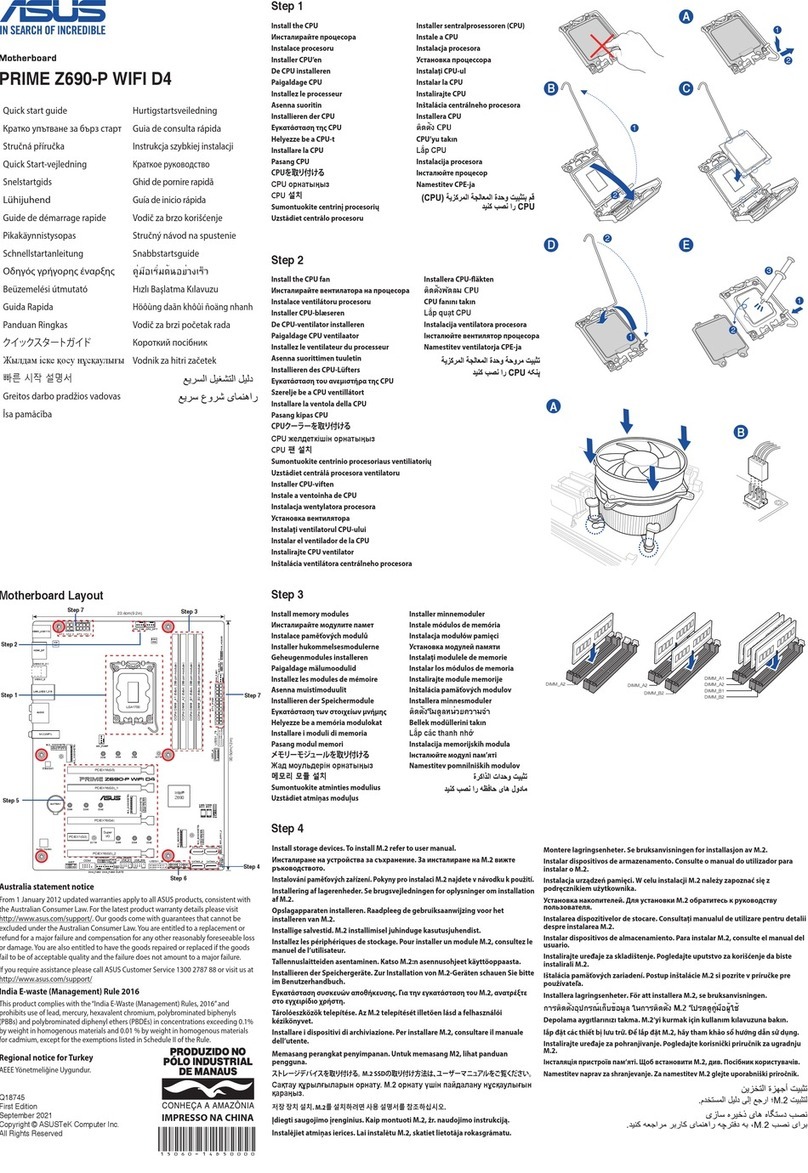Intel DQ33HS User manual

Intel®Desktop Board DQ33HS
Product Guide
Order Number: E20672-001

Revision History
Revision Revision History Date
-001 First release of the Intel®Desktop Board DQ33HS Product Guide August 2007
If an FCC declaration of conformity marking is present on the board, the following statement applies:
FCC Declaration of Conformity
This device complies with Part 15 of the FCC Rules. Operation is subject to the following two conditions:
(1) this device may not cause harmful interference, and (2) this device must accept any interference
received, including interference that may cause undesired operation.
For questions related to the EMC performance of this product, contact:
Intel Corporation, 5200 N.E. Elam Young Parkway, Hillsboro, OR 97124
1-800-628-8686
This equipment has been tested and found to comply with the limits for a Class B digital device, pursuant to
Part 15 of the FCC Rules. These limits are designed to provide reasonable protection against harmful
interference in a residential installation. This equipment generates, uses, and can radiate radio frequency
energy and, if not installed and used in accordance with the instructions, may cause harmful interference to
radio communications. However, there is no guarantee that interference will not occur in a particular
installation. If this equipment does cause harmful interference to radio or television reception, which can be
determined by turning the equipment off and on, the user is encouraged to try to correct the interference by
one or more of the following measures:
•Reorient or relocate the receiving antenna.
•Increase the separation between the equipment and the receiver.
•Connect the equipment to an outlet on a circuit other than the one to which the receiver is connected.
•Consult the dealer or an experienced radio/TV technician for help.
Any changes or modifications to the equipment not expressly approved by Intel Corporation could void the
user’s authority to operate the equipment.
Tested to comply with FCC standards for home or office use.
Canadian Department of Communications Compliance Statement
This digital apparatus does not exceed the Class B limits for radio noise emissions from digital apparatus set
out in the Radio Interference Regulations of the Canadian Department of Communications.
Le présent appareil numerique német pas de bruits radioélectriques dépassant les limites applicables aux
appareils numériques de la classe B prescrites dans le Réglement sur le broullage radioélectrique édicté par
le ministére des Communications du Canada.
Disclaimer
INFORMATION IN THIS DOCUMENT IS PROVIDED IN CONNECTION WITH INTEL®PRODUCTS. NO LICENSE,
EXPRESS OR IMPLIED, BY ESTOPPEL OR OTHERWISE, TO ANY INTELLECTUAL PROPERTY RIGHTS IS
GRANTED BY THIS DOCUMENT. EXCEPT AS PROVIDED IN INTEL’S TERMS AND CONDITIONS OF SALE FOR
SUCH PRODUCTS, INTEL ASSUMES NO LIABILITY WHATSOEVER, AND INTEL DISCLAIMS ANY EXPRESS OR
IMPLIED WARRANTY, RELATING TO SALE AND/OR USE OF INTEL PRODUCTS INCLUDING LIABILITY OR
WARRANTIES RELATING TO FITNESS FOR A PARTICULAR PURPOSE, MERCHANTABILITY, OR INFRINGEMENT
OF ANY PATENT, COPYRIGHT OR OTHER INTELLECTUAL PROPERTY RIGHT. Intel products are not intended
for use in medical, life saving, or life sustaining applications. Intel may make changes to specifications and
product descriptions at any time, without notice.
Desktop Board DQ33HS may contain design defects or errors known as errata which may cause the product
to deviate from published specifications. Current characterized errata are available on request.
Contact your local Intel sales office or your distributor to obtain the latest specifications and before placing
your product order.
Copies of documents which have an ordering number and are referenced in this document, or other Intel
literature, may be obtained from Intel Corporation by going to the World Wide Web site at:
http://www.intel.com/ or by calling 1-800-548-4725.
Intel, the Intel logo, Pentium, and Celeron are trademarks of Intel Corporation in the United States and
other countries.
* Other names and brands may be claimed as the property of others.
Copyright © 2007, Intel Corporation. All rights reserved.

iii
Preface
This Product Guide gives information about board layout, component installation, BIOS
update, and regulatory requirements for Intel®Desktop Board DQ33HS.
Intended Audience
The Product Guide is intended for technically qualified personnel. It is not intended for
general audiences.
Use Only for Intended Applications
All Intel Desktop Boards are evaluated as Information Technology Equipment (I.T.E.)
for use in personal computers (PC) for installation in homes, offices, schools, computer
rooms, and similar locations. The suitability of this product for other PC or embedded
non-PC applications or other environments, such as medical, industrial, alarm systems,
test equipment, etc., may not be supported without further evaluation by Intel.
Document Organization
The chapters in this Product Guide are arranged as follows:
1 Desktop Board Features: a summary of product features
2 Installing and Replacing Desktop Board Components: instructions on how to install
the Desktop Board and other hardware components
3 Updating the BIOS: instructions on how to update the BIOS
A Error Messages and Indicators: information about BIOS error messages and beep
codes
B Regulatory Compliance: safety and EMC regulations and product certifications
Conventions
The following conventions are used in this manual:
CAUTION
Cautions warn the user about how to prevent damage to hardware or loss of data.
NOTE
Notes call attention to important information.

Intel Desktop Board DQ33HS Product Guide
iv
Terminology
The table below gives descriptions of some common terms used in the product guide.
Term Description
GB Gigabyte (1,073,741,824 bytes)
GHz Gigahertz (one billion hertz)
KB Kilobyte (1024 bytes)
MB Megabyte (1,048,576 bytes)
Mbit Megabit (1,048,576 bits)
MHz Megahertz (one million hertz)

v
Contents
1Desktop Board Features
Supported Operating Systems..............................................................................11
Desktop Board Components.................................................................................12
Processor..........................................................................................................14
Main Memory.....................................................................................................14
Intel®Q33 Express Chipset .................................................................................15
Intel Q33 Graphics Subsystem......................................................................16
Intel®GMA 3100 Graphics Controller......................................................16
Audio Subsystem ...............................................................................................17
Legacy Input/Output (I/O) Controller ....................................................................18
LAN Subsystem .................................................................................................18
LAN Status LEDs.........................................................................................19
Hi-Speed USB 2.0 Support ..................................................................................19
Enhanced IDE Interface ......................................................................................20
Serial ATA.........................................................................................................20
Expandability.....................................................................................................20
BIOS................................................................................................................20
Serial ATA and IDE Auto Configuration...........................................................20
PCI* and PCI Express* Auto Configuration .....................................................20
Security Passwords.....................................................................................21
Trusted Platform Module (TPM) ............................................................................21
Hardware Management Features ..........................................................................21
Hardware Monitoring and Fan Speed Control ..................................................22
Chassis Intrusion........................................................................................22
Power Management Features ...............................................................................22
ACPI.........................................................................................................23
Hardware Support ......................................................................................23
Power Connectors ...............................................................................23
Fan Headers .......................................................................................23
LAN Wake Capabilities..........................................................................24
Instantly Available PC Technology..........................................................24
+5 V Standby Power Indicator...............................................................25
Wake from USB ..................................................................................25
PME# Signal Wake-up Support..............................................................25
WAKE# Signal Wake-up Support ...........................................................25
ENERGY STAR* Capable ..............................................................................26
Speaker............................................................................................................26
Battery.............................................................................................................26
Real-Time Clock.................................................................................................26
2Installing and Replacing Desktop Board Components
Before You Begin ...............................................................................................27
Installation Precautions.......................................................................................28
Prevent Power Supply Overload ....................................................................28
Observe Safety and Regulatory Requirements.................................................28
Installing the I/O Shield ......................................................................................29
Installing and Removing the Desktop Board ...........................................................30

Intel Desktop Board DQ33HS Product Guide
vi
Installing and Removing a Processor.....................................................................31
Installing a Processor ..................................................................................31
Installing the Processor Fan Heat Sink ...........................................................34
Connecting the Processor Fan Heat Sink Cable................................................35
Removing the Processor ..............................................................................36
Installing and Removing Memory..........................................................................36
Guidelines for Dual Channel Memory Configuration..........................................37
Two or Four DIMMs .............................................................................37
Three DIMMs ......................................................................................38
Installing DIMMs ........................................................................................39
Removing DIMMs........................................................................................41
Installing and Removing a PCI Express x16 Card ....................................................42
Installing a PCI Express x16 Card .................................................................42
Removing the PCI Express x16 Card..............................................................43
Connecting the IDE Cable....................................................................................44
Connecting the Serial ATA (SATA) Cables ..............................................................46
Connecting to the Internal Headers ......................................................................47
Connecting to the HD Audio Link Header........................................................48
Installing a Front Panel Audio Solution for Intel®High Definition Audio ...............48
Connecting to the Chassis Intrusion Header....................................................49
Connecting to the Serial Port Header .............................................................49
Connecting to the Alternate Front Panel Power LED Header...............................50
Connecting to the Front Panel Header............................................................50
Connecting to the USB 2.0 Headers...............................................................51
Connecting to the Audio System...........................................................................51
Connecting Chassis Fan and Power Supply Cables...................................................52
Connecting Chassis Fan Cables .....................................................................52
Connecting Supply Power Cables ..................................................................53
Setting the BIOS Configuration Jumper .................................................................54
Clearing Passwords ............................................................................................56
Replacing the Battery .........................................................................................57
3Updating the BIOS
Updating the BIOS with the Intel®Express BIOS Update Utility.................................63
Updating the BIOS with the ISO Image BIOS Update File or the Iflash Memory
Update Utility...............................................................................................64
Obtaining the BIOS Update File ....................................................................64
Updating the BIOS with the ISO Image BIOS Update File .................................64
Updating the BIOS with the Iflash Memory Update Utility .................................65
Recovering the BIOS...................................................................................66
AError Messages and Indicators
BIOS Beep Codes...............................................................................................67
BIOS Error Messages..........................................................................................67
BRegulatory Compliance
Safety Standards ...............................................................................................69
Place Battery Marking .................................................................................69
European Union Declaration of Conformity Statement..............................................70
Product Ecology Statements ................................................................................71
Recycling Considerations .............................................................................71
Lead-free 2LI/Pb-free 2LI Board ...................................................................74

Contents
vii
Restriction of Hazardous Substances (RoHS) ..................................................75
EU RoHS ............................................................................................75
China RoHS ........................................................................................75
EMC Regulations ................................................................................................78
Ensure Electromagnetic Compatibility (EMC) Compliance..................................79
Product Certifications..........................................................................................80
Board-Level Certification Markings ................................................................80
Chassis and Component Certifications............................................................81
Figures
1. Desktop Board DQ33HS Components ..............................................................12
2. LAN Status LEDs ..........................................................................................19
3. Standby Power Indicator................................................................................25
4. Installing the I/O Shield ................................................................................29
5. Desktop Board DQ33HS Mounting Screw Hole Locations.....................................30
6. Lift the Socket Lever .....................................................................................31
7. Lift the Load Plate.........................................................................................32
8. Remove the Protective Socket Cover ...............................................................32
9. Remove the Processor from the Protective Processor Cover ................................33
10. Install the Processor .....................................................................................33
11. Close the Load Plate .....................................................................................34
12. Connecting the Processor Fan Heat Sink Cable to the Processor Fan Header..........35
13. Dual Channel Memory Configuration with Two DIMMs ........................................37
14. Dual Channel Memory Configuration with Four DIMMs........................................37
15. Dual Channel Memory Configuration with Three DIMMs......................................38
16. Use DDR2 DIMMs .........................................................................................39
17. Installing a DIMM .........................................................................................40
18. Installing a PCI Express x16 Card ...................................................................42
19. Removing a PCI Express x16 Card ..................................................................43
20. Connecting the IDE Cable ..............................................................................45
21. Connecting a Serial ATA Cable........................................................................46
22. Internal Headers ..........................................................................................47
23. Back Panel Audio Connectors .........................................................................51
24. Location of the Chassis Fan Headers................................................................52
25. Connecting Power Supply Cables ....................................................................53
26. Location of the BIOS Configuration Jumper Block ..............................................54
27. Removing the Battery ...................................................................................61
28. Desktop Board DQ33HS China RoHS Material Self Declaration Table ....................77
Tables
1. Feature Summary.......................................................................................... 9
2. Desktop Board DQ33HS Components ..............................................................13
3. LAN Status LEDs ..........................................................................................19
4. HD Audio Link Header Signal Names ...............................................................48
5. Front Panel Intel High Definition Audio Header Signal Names ..............................48
6. Chassis Intrusion Header ...............................................................................49
7. Serial Port Header Signal Names.....................................................................49
8. Alternate Front Panel Power LED Header ..........................................................50
9. Front Panel Header .......................................................................................50

Intel Desktop Board DQ33HS Product Guide
viii
10. USB 2.0 Header Signal Names........................................................................51
11. Jumper Settings for the BIOS Setup Program Modes..........................................55
12. Beep Codes .................................................................................................67
13. BIOS Error Messages ....................................................................................67
14. Safety Standards..........................................................................................69
15. Lead-Free Second Level Interconnect Marks .....................................................75
16. China RoHS Environmentally Friendly Use Period Mark .......................................76
17. EMC Regulations...........................................................................................78
18. Product Certification Markings ........................................................................80

9
1 Desktop Board Features
This chapter briefly describes the features of Intel®Desktop Board DQ33HS. Table 1
summarizes the major features of the Desktop Board.
Table 1. Feature Summary
Form Factor microATX (243.84 millimeters [9.60 inches] x 243.84 millimeters
[9.60 inches])
Processor Support for an Intel®processor in the LGA775 package
Main Memory •Four 240-pin, DDR2 1.8 V (only) SDRAM Dual Inline Memory Module
(DIMM) sockets
•800/667 MHz single or dual channel DDR2 SDRAM interface
•Support for up to 8 GB of system memory
Chipset Intel®Q33 Express Chipset consisting of:
•Intel®Q33 Express Chipset Graphics and Memory Controller Hub
(GMCH)
•Intel®82801IB I/O Controller Hub (ICH9)
Graphics •Intel®Graphics Media Accelerator 3100 (Intel®GMA 3100) graphics
controller
•One PCI Express* x16 connector supporting PCI Express graphics
cards
Audio •4-channel (2 + 2) onboard audio subsystem featuring:
―Intel®High Definition Audio interface
―RealTek* ALC268-GR audio codec
•HD Audio Link header
LAN Support Intel®82566DM Gigabit (10/100/1000 Mb/s) Ethernet LAN controller
Expansion
Capabilities
•One PCI Express x16 connector
•Two PCI Express x1 connectors
•One PCI* connector
Legacy I/O Support Legacy I/O Controller that provides one serial port via an onboard
header
Peripheral
Interfaces
•Up to 12 USB 2.0 ports
―Six ports routed to the back panel
―Six ports routed to three USB headers
•Four Serial ATA (SATA) channels (3.0 Gb/s), via the ICH9, including
one external SATA (eSATA) channel
•One IDE interface with ATA-66/100 support for two devices
continued

Intel Desktop Board DQ33HS Product Guide
10
Table 1. Feature Summary (continued)
Trusted Platform
Module (TPM),
revision 1.2
One TPM 1.2 device to enhance platform security
BIOS •Intel®Platform Innovation Framework for extensible firmware
interface
•32 Mbit symmetrical flash memory device
•Support for SMBIOS
•Intel®Rapid BIOS Boot
•Intel®Express BIOS Update
Power Management •Support for Advanced Configuration and Power Interface (ACPI)
•Suspend to RAM (STR)
•Wake on USB, PCI Express, LAN, and front panel
•ENERGY STAR* capable
Hardware
Management
Hardware monitor with:
•Intel®Quiet System Technology fan speed control
•Three fan sensing inputs used to monitor fan activity
•Voltage sensing to detect out of range values
Related Links:
For more information about Desktop Board DQ33HS, including the Technical Product
Specification (TPS), BIOS updates, and device drivers, go to:
http://www.intel.com/cd/channel/reseller/asmo-na/eng/368133.htm

Desktop Board Features
11
Supported Operating Systems
The Desktop Board supports the following operating systems:
•Microsoft Windows Vista* Ultimate
•Microsoft Windows Vista Enterprise
•Microsoft Windows Vista Business
•Microsoft Windows Vista Home Premium
•Microsoft Windows Vista Home Basic
•Microsoft Windows Vista Ultimate 64-bit edition
•Microsoft Windows Vista Enterprise 64-bit edition
•Microsoft Windows Vista Business 64-bit edition
•Microsoft Windows Vista Home Premium 64-bit edition
•Microsoft Windows Vista Home Basic 64-bit edition
•Microsoft Windows* XP Professional
•Microsoft Windows XP Professional x64 Edition

Intel Desktop Board DQ33HS Product Guide
12
Desktop Board Components
Figure 1 shows the approximate location of the major components on Desktop Board
DQ33HS.
Figure 1. Desktop Board DQ33HS Components

Desktop Board Features
13
Table 2. Desktop Board DQ33HS Components
Label Description
A Front panel audio header
B Speaker
C PCI bus connector
D PCI Express x1 connector 2
E Battery
F PCI Express x1 connector 1
G PCI Express x16 connector
H Rear chassis fan header (3-pin)
I Back panel connectors
J 12 V processor core voltage connector (2 x 2 pin)
K Processor socket
L Processor fan header (4-pin)
M Serial header
N Main power connector (2 x 12 pin)
O DDR2 DIMM 0 sockets
P DDR2 DIMM 1 sockets
Q Front panel header
R Alternate front panel power LED header
S Chassis intrusion header
T BIOS configuration jumper block
U Front chassis fan header (3-pin)
V Serial ATA connectors (3)
W External SATA (eSATA) connector
X High-speed USB 2.0 header 2
Y High-speed USB 2.0 header 3
Z High-speed USB 2.0 header 1
AA IDE connector
BB High Definition Audio Link header

Intel Desktop Board DQ33HS Product Guide
14
Processor
CAUTION
Failure to use an appropriate power supply and/or not connecting the 12 V (2 x 2 pin)
power connector to the Desktop Board may result in damage to the board, or the
system may not function properly.
Desktop Board DQ33HS supports an Intel processor in the LGA775 package.
Processors are not included with the Desktop Board and must be purchased
separately. The processor connects to the Desktop Board through the LGA775 socket.
Related Links:
Go to the following page for more information about:
•Instructions on installing or upgrading the processor, page 31 in Chapter 2
Main Memory
NOTE
To be fully compliant with all applicable Intel
®SDRAM memory specifications, the
board should be populated with DIMMs that support the Serial Presence Detect (SPD)
data structure. If your memory modules do not support SPD, you will see a
notification to this effect on the screen at power up. The BIOS will attempt to
configure the memory controller for normal operation.

Desktop Board Features
15
The Desktop Board supports the dual or single channel memory configurations defined
below.
•Four 240-pin Double Data Rate 2 (DDR2) SDRAM Dual Inline Memory Module
(DIMM) connectors with gold-plated contacts, 1.8 V only
•Support for:
⎯Unbuffered, non-registered single or double-sided DIMMs
⎯Non-ECC DDR2 memory
⎯DIMM Type and Timings listed below:
Type Timing
DDR2-800 5-5-5 or 6-6-6 only
DDR2-667 5-5-5 only
⎯Serial Presence Detect (SPD) memory only
⎯Memory configurations listed below:
•Up to 2.0 GB utilizing 256 Mb technology
•Up to 4.0 GB utilizing 512 Mb or 1 Gb technology
•Up to 8.0 GB utilizing 1 Gb technology
Related Links:
Go to the following links or pages for more information about:
•SDRAM specifications, http://www.intel.com/technology/memory/
•Installing memory, page 36 in Chapter 2
•PC Serial Presence Detect Specification,
http://www.intel.com/technology/memory/ddr/specs/dda8c16_32x64ag_a.pdf
Intel®Q33 Express Chipset
The Intel Q33 Express Chipset consists of the following devices:
•Intel Q33 Express Chipset Graphics and Memory Controller Hub (GMCH) with Direct
Media Interface (DMI)
•Intel 82801IB I/O Controller Hub (ICH9) with DMI
The GMCH component provides interfaces to the processor, memory, PCI Express bus,
and the DMI interconnect. The component also provides integrated graphics
capabilities supporting 3D, 2D, and display capabilities.
ICH9 is a centralized controller for the board’s I/O paths.
Related Links:
Go to the following link for more information about the Intel Q33 Express Chipset:
http://developer.intel.com/products/chipsets/index.htm

Intel Desktop Board DQ33HS Product Guide
16
Intel Q33 Graphics Subsystem
The Intel Q33 Express Chipset contains two separate, mutually exclusive graphics
options. Either the integrated Intel®Graphics Media Accelerator 3100 (Intel®
GMA 3100) graphics controller is used or a PCI Express x16 add-in card can be used.
When a PCI Express x16 add-in card is installed, the Intel GMA 3100 graphics
controller is disabled.
Intel®GMA 3100 Graphics Controller
The Intel GMA 3100 graphics controller features the following:
•400 MHz core frequency
•High quality texture engine:
⎯DX9.0c* and OpenGL* 1.4 compliant
⎯Hardware Pixel Shader 2.0
⎯Vertex Shader Model 2.0
•3D Graphics Rendering enhancements:
⎯1.6 dual texture GigaPixel/s maximum fill rate
⎯16-bit and 32-bit color
⎯Vertex cache
•Video
⎯Software DVD at 30 fps full screen
⎯Dynamic Video Memory Technology (DVMT) supports up to 287 MB
•Display
⎯Up to 2048 x 1536 at 75 Hz refresh (QXGA)
⎯DDC2B compliant interface with Advanced Digital Display 2 card or Media
Expansion Card (ADD2/MEC), support for TV-out/TV-in and DVI digital display
connections
NOTE
A minimum of 512 MB of system memory is required in order for the Intel GMA 3100
graphics controller to operate properly.

Desktop Board Features
17
Audio Subsystem
The onboard audio subsystem consists of the following:
•Intel®ICH9 I/O controller hub
•RealTek ALC268-GR audio codec
•Back panel audio connectors
•Onboard audio headers:
⎯Intel High Definition Audio front panel header
⎯HD Audio Link header
The audio subsystem supports the following features:
•A signal-to-noise (S/N) ratio of ≤95 dB playback quality and ≤90 dB recording
quality
•Independent stereo audio playback from back panel connectors and the Intel High
Definition Audio front panel header
Related Links:
Go to the following pages for more information about:
•Installing the front panel audio solution, page 48
•The location of audio connectors, Figure 23 on page 51

Intel Desktop Board DQ33HS Product Guide
18
Legacy Input/Output (I/O) Controller
The I/O controller features the following:
•One serial port interface via an onboard header
•Low pin count (LPC) interface
•Serial IRQ interface compatible with serialized IRQ support for PCI systems
•Intelligent power management, including a programmable wake up event interface
•PCI power management support
LAN Subsystem
The LAN subsystem includes:
•Intel ICH9
•Intel 82566DM Gigabit (10/100/1000 Mb/s) Ethernet LAN controller
•RJ-45 LAN connector with integrated LAN status LEDs
The subsystem also features:
•CSMA/CD protocol engine
•LAN connect interface between ICH9 and the LAN controller
•PCI bus power management

Desktop Board Features
19
LAN Status LEDs
Two LEDs are built into the RJ-45 LAN connector located on the back panel (see
Figure 2). These LEDs indicate the status of the LAN.
Figure 2. LAN Status LEDs
Table 3 describes the LED states when the board is powered up and the LAN
subsystem is operating.
Table 3. LAN Status LEDs
LED LED Color LED State Indicates
A Off LAN link is not established
Green
On LAN link is established
Blinking LAN activity is occurring
N/A Off 10 Mb/s data rate
Green On 100 Mb/s data rate
B
Yellow On 1000 Mb/s data rate
Hi-Speed USB 2.0 Support
The Desktop Board supports up to 12 USB 2.0 ports (six ports routed to the back
panel and six ports routed to three internal headers) via ICH9. USB 2.0 ports are
backward compatible with USB 1.1 devices. USB 1.1 devices will function normally at
USB 1.1 speeds.
USB 2.0 support requires both an operating system and drivers that fully support
USB 2.0 transfer rates. Disabling Hi-Speed USB in the BIOS reverts all USB 2.0 ports
to USB 1.1 operation. This may be required to accommodate operating systems that
do not support USB 2.0.

Intel Desktop Board DQ33HS Product Guide
20
Enhanced IDE Interface
The board’s IDE interface handles the exchange of information between the processor
and peripheral devices such as hard disk drives and CD-ROM drives. The interface
supports:
•Up to two IDE devices (such as hard drives)
•ATAPI-style devices (such as CD-ROM drives)
•Older PIO Mode devices
•Ultra DMA-33 and ATA-66/100 protocols
Serial ATA
The Desktop Board supports four Serial ATA channels (3.0 Gb/s) via ICH9, connecting
one device per channel. One channel is configured as an eSATA channel.
Expandability
For system expansion, the Desktop Board provides the following expansion slots:
•Two PCI Express x1 connectors
•One PCI Express x16 connector
•One PCI bus connector
BIOS
The BIOS provides the Power-On Self-Test (POST), the BIOS Setup program, the
PCI/PCI Express and IDE auto-configuration utilities, and the video BIOS. The BIOS is
stored in the Serial Peripheral Interface (SPI) Flash.
The BIOS can be updated by following the instructions on page 63 in Chapter 3.
Serial ATA and IDE Auto Configuration
If you install a Serial ATA or IDE device (such as a hard drive) in your computer, the
auto-configuration utility in the BIOS automatically detects and configures the device
for your computer. You do not need to run the BIOS Setup program after installing a
Serial ATA or IDE device. You can override the auto-configuration options by
specifying manual configuration in the BIOS Setup program.
PCI* and PCI Express* Auto Configuration
If you install a PCI/PCI Express add-in card in your computer, the PCI/PCI Express
auto-configuration utility in the BIOS automatically detects and configures the
resources (IRQs, DMA channels, and I/O space) for that add-in card. You do not need
to run the BIOS Setup program after you install a PCI/PCI Express add-in card.
Table of contents
Other Intel Motherboard manuals
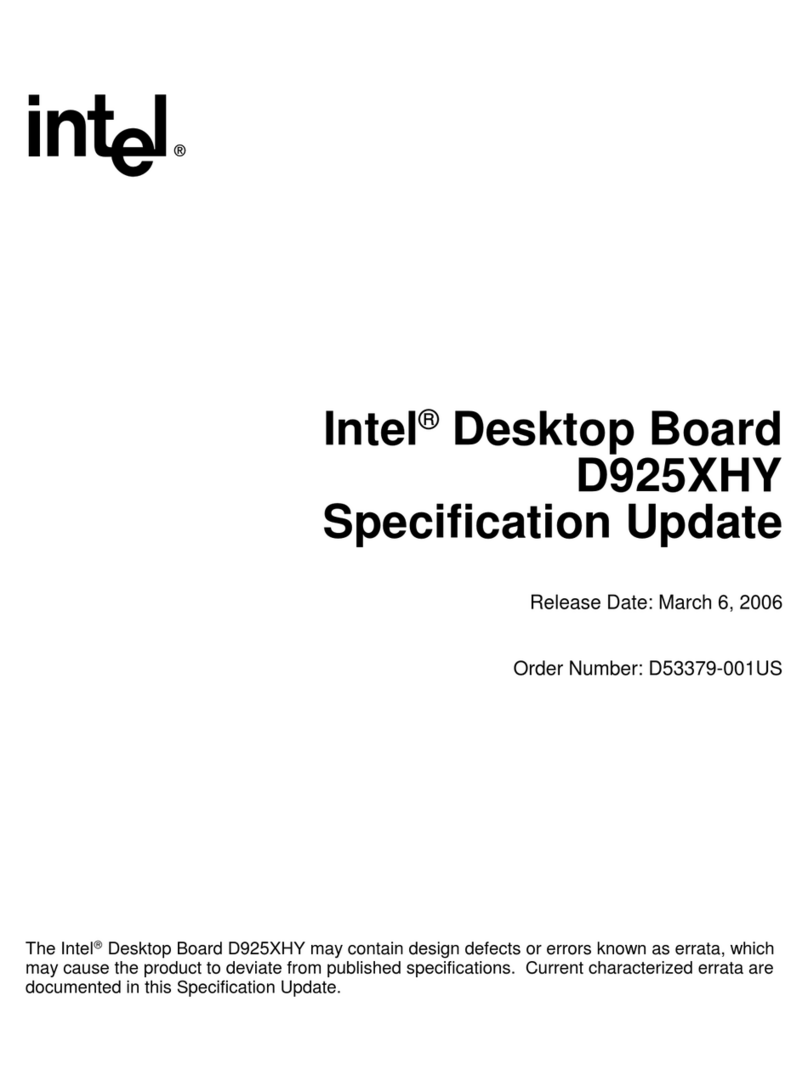
Intel
Intel D925XHY User manual

Intel
Intel BLKD201GLYL Configuration guide

Intel
Intel D425KT Configuration guide

Intel
Intel D915GVWB User manual
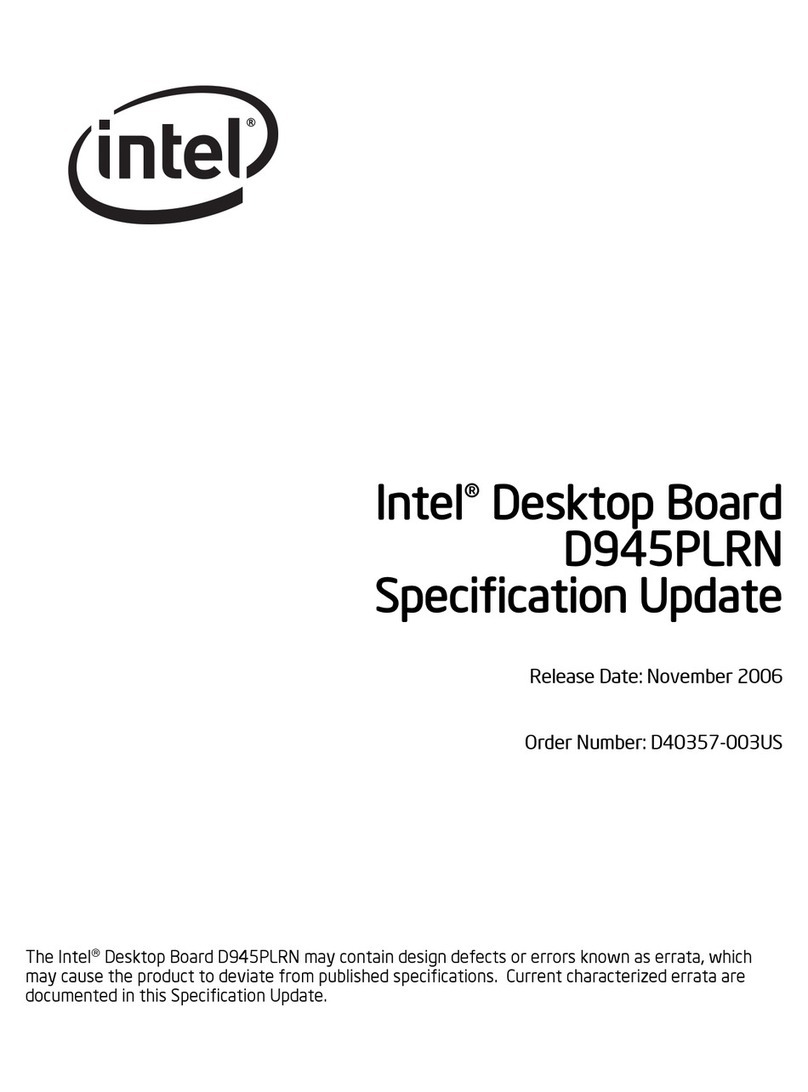
Intel
Intel D945PLRN User manual
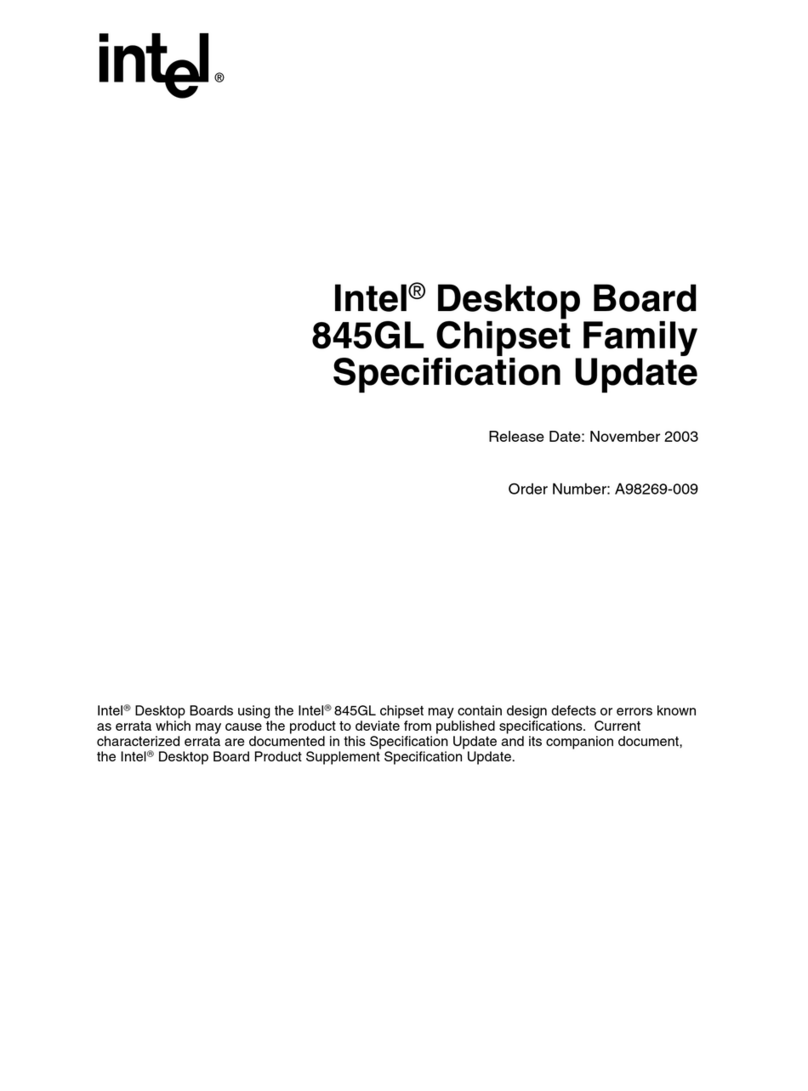
Intel
Intel Desktop Board D845GLLY User manual
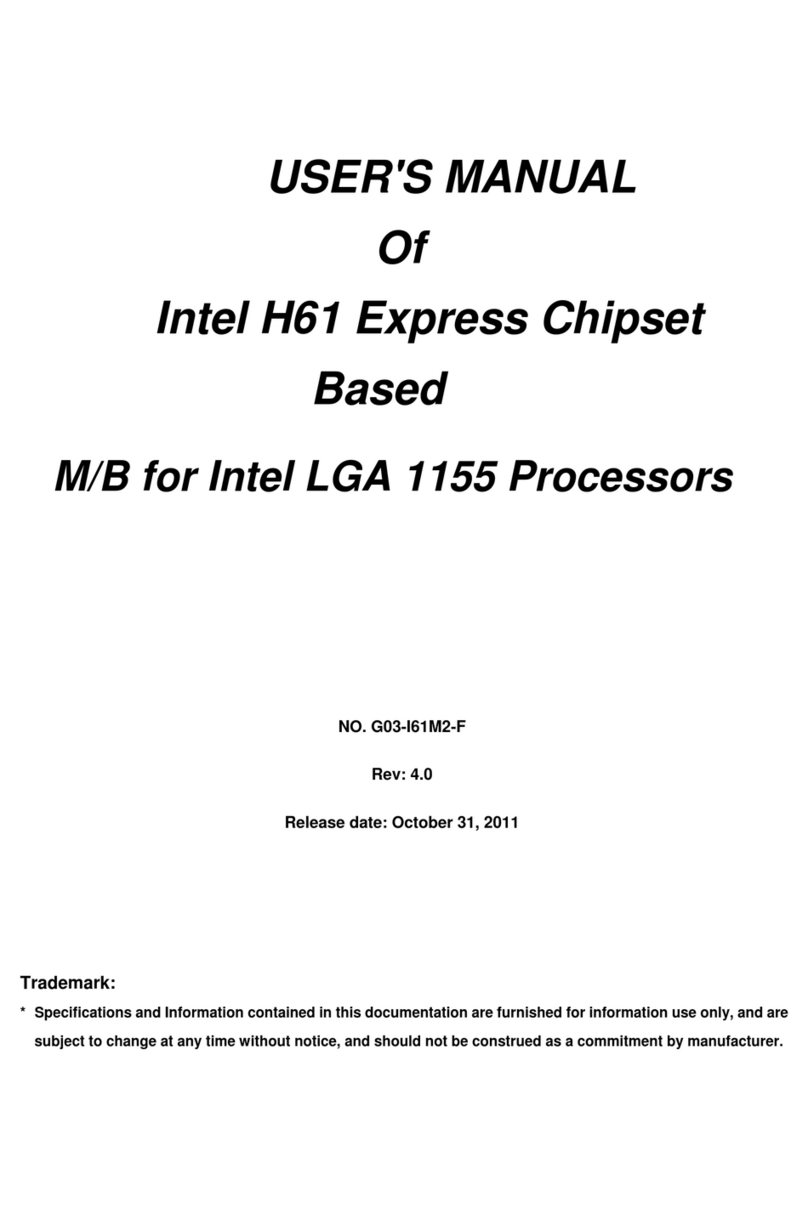
Intel
Intel H61 Series User manual
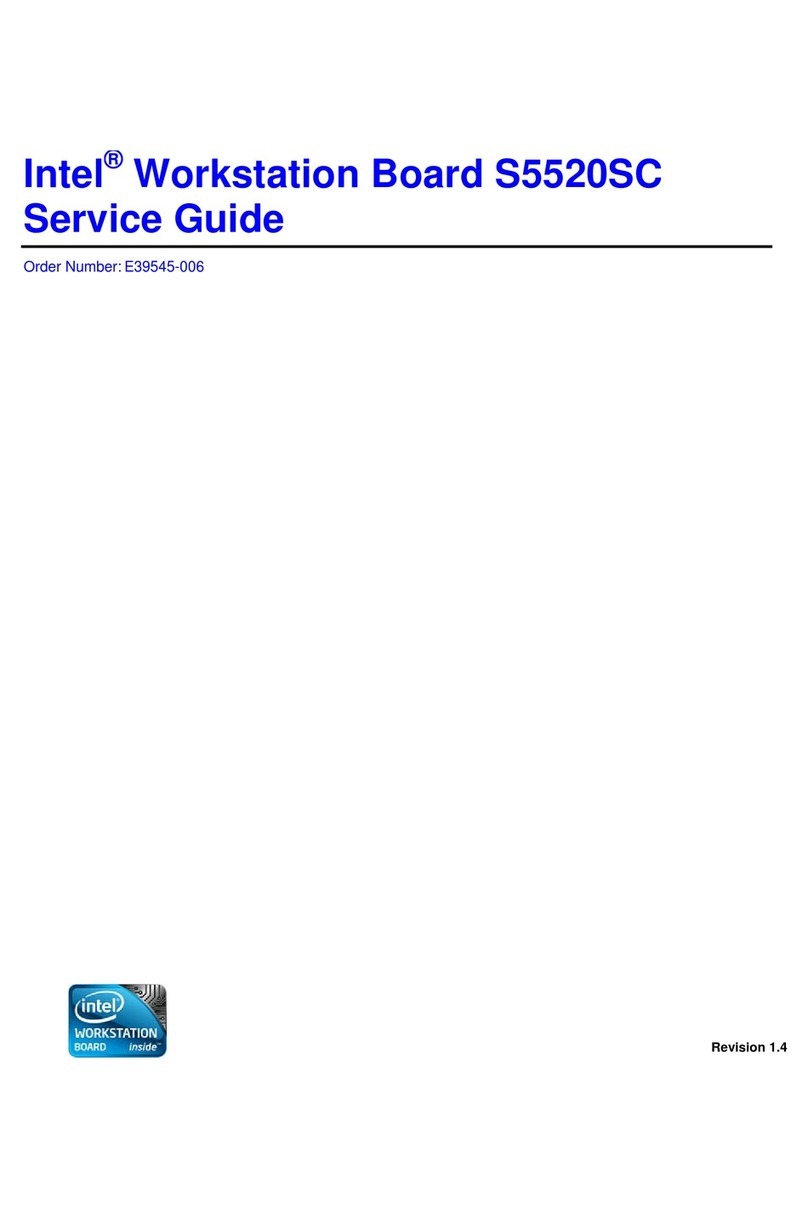
Intel
Intel S5520SC User manual
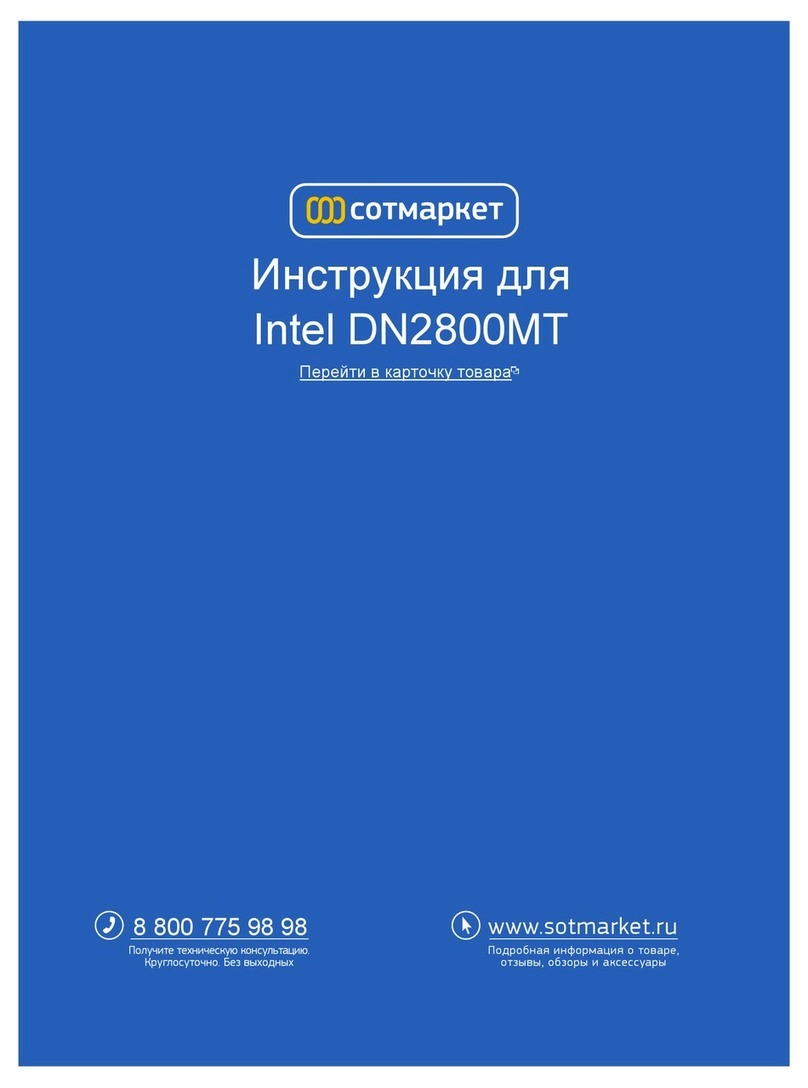
Intel
Intel DN2800MT Configuration guide

Intel
Intel MAX 10 FPGA User manual
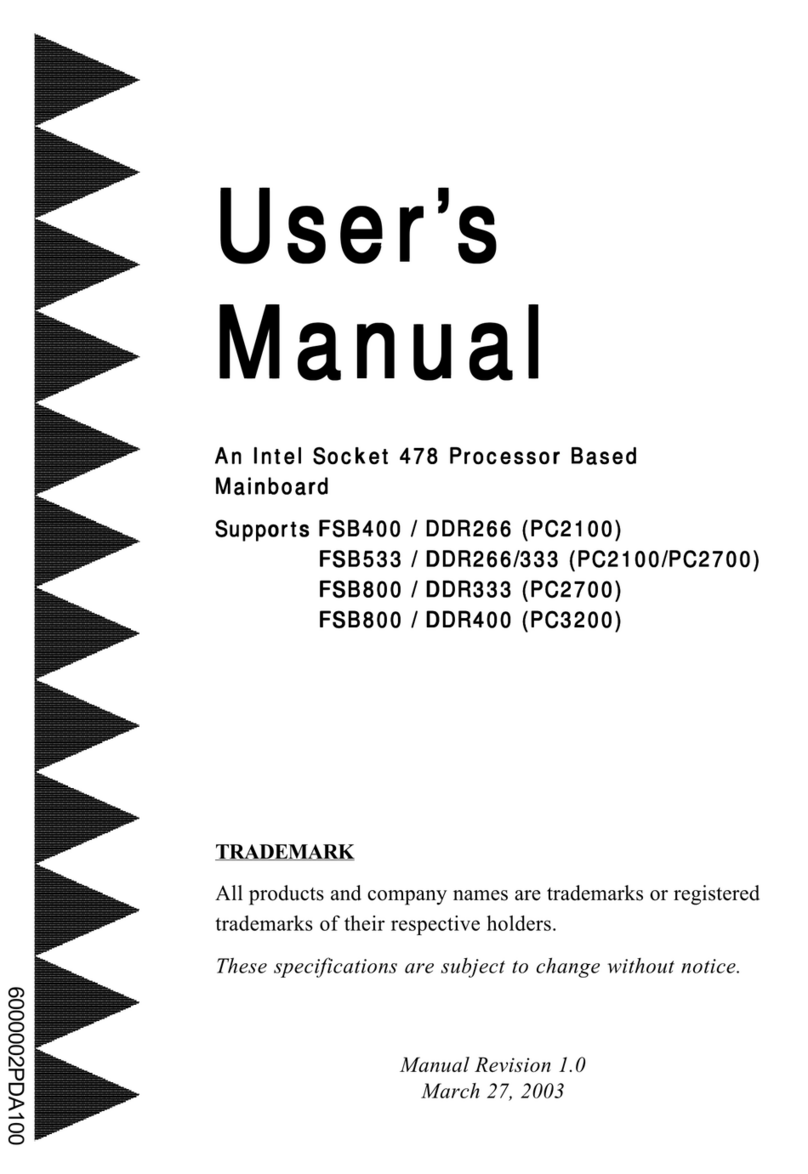
Intel
Intel DDR266 (PC2100) User manual
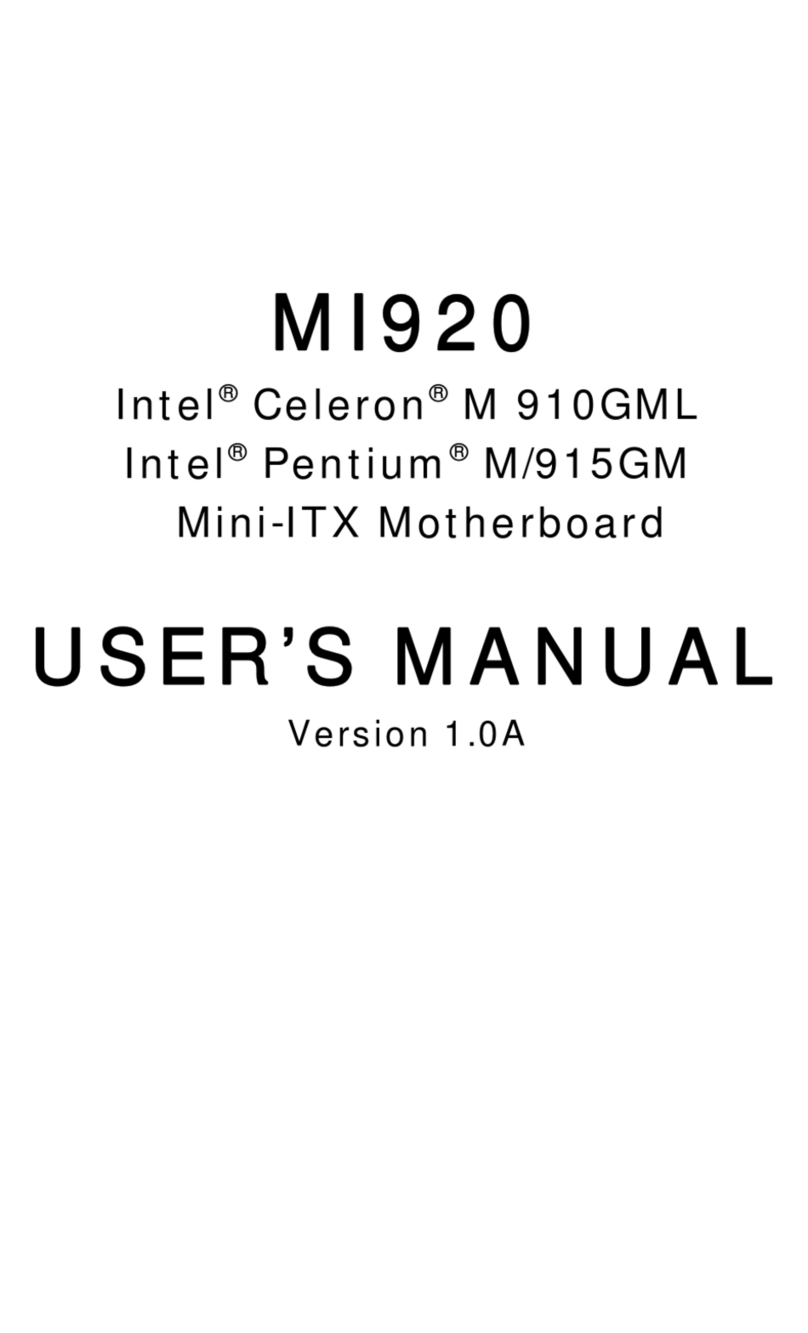
Intel
Intel M 910GML User manual
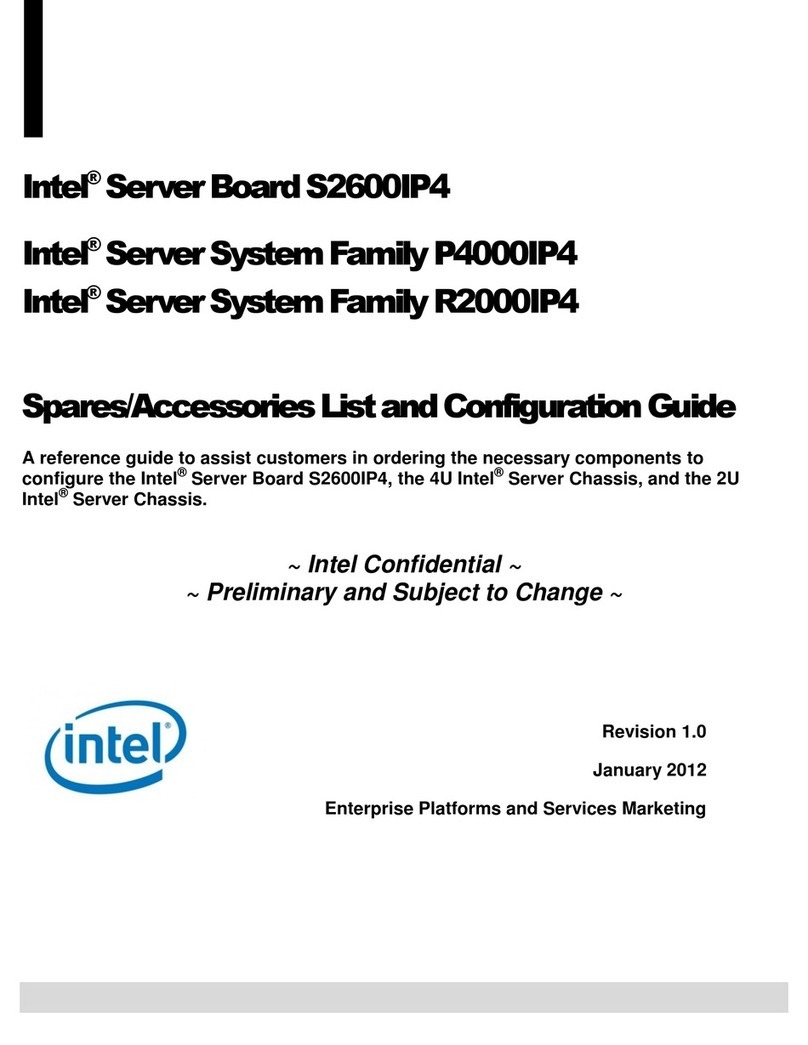
Intel
Intel S2600IP4 User manual

Intel
Intel PT-6IBD User manual

Intel
Intel AL440LX User manual
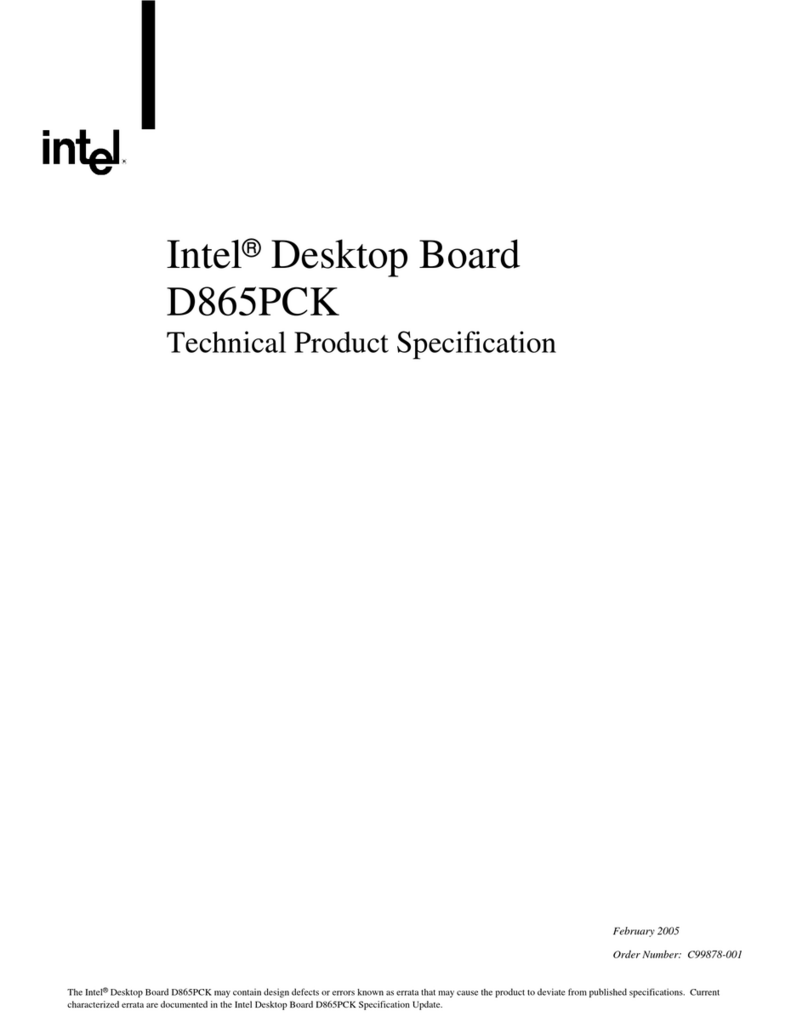
Intel
Intel D865PCK User manual
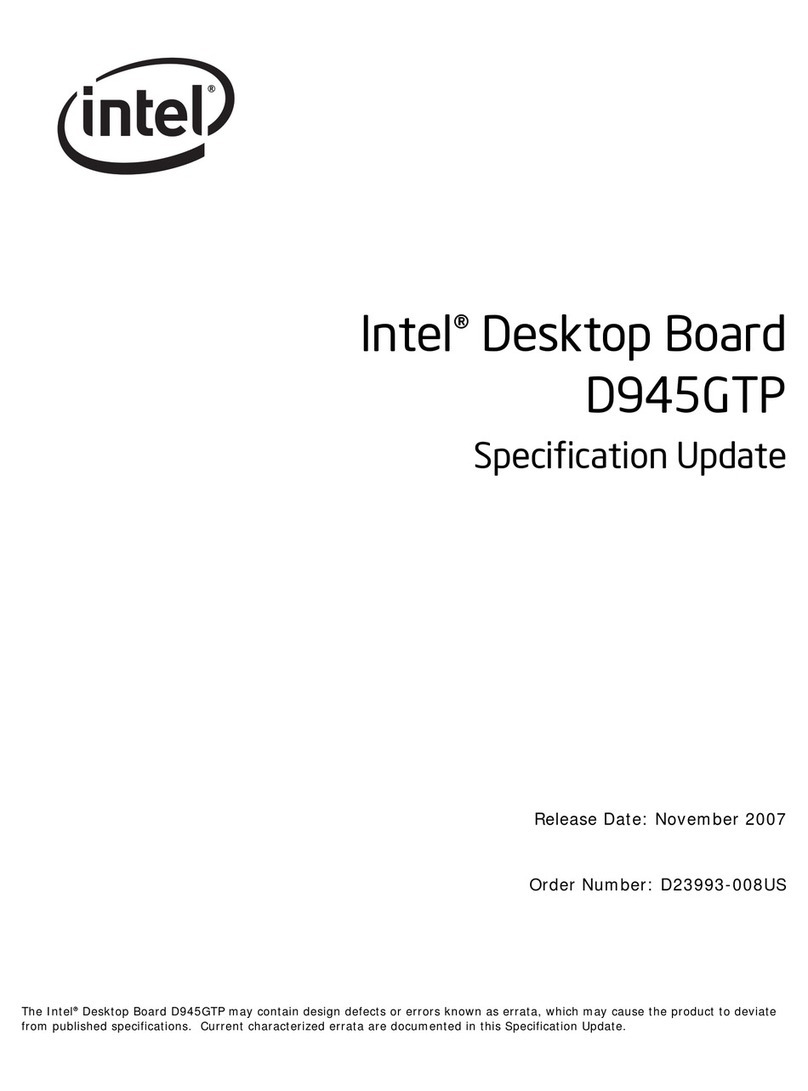
Intel
Intel D945GTP User manual
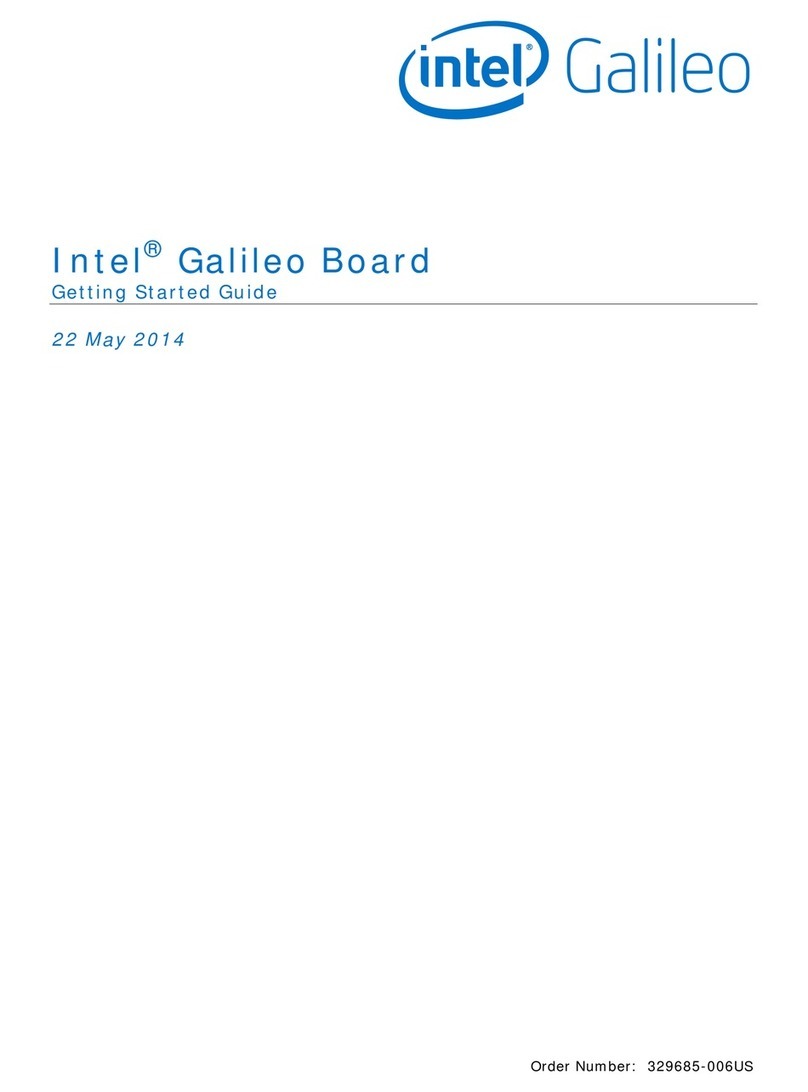
Intel
Intel Galileo User manual

Intel
Intel DQ57TM User manual
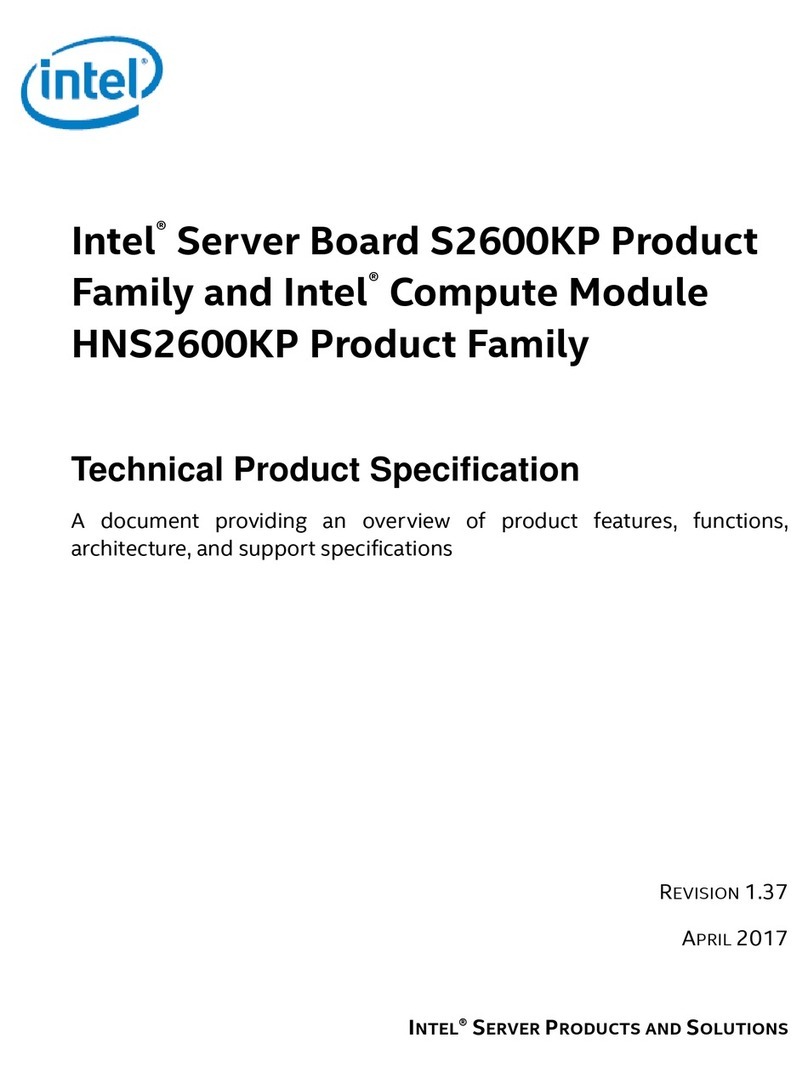
Intel
Intel S2600KPFR Installation instructions
